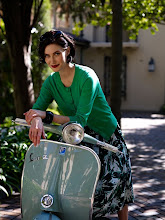Blue Valentine - Film Review
You always hurt the ones you love; so if Cianfrance wreaks havoc on your heart, you’ll realise he dotes duly on his audience.
Director Derek Cianfrance’s second narrative feature opens skilfully with an ambient sequence of Frankie, the three-year-old daughter of protagonists Cindy and Dean, searching for the family dog at first light. The allusion to sentimentality is at once subdued and deafening. It calls to mind Stephanie Vaughn’s 1989 short story Dog Heaven. Vaughn’s canine plays out a complex suite of roles: simultaneously real and imaginary; the vehicle of memory, a childhood companion, a legend, a metaphor for the loss of innocence; the last breakwater of childhood ideals against an imminent front of reality. And so, with such soft, atmospheric gesture, we are delicately inducted into the greater sense of unease in this tale of middle-class, Anglo-American family life. With this symbolic canine vacuum revealed, the audience is gradually drawn in to the momentum of Cindy and Dean’s complex relationship: the missing piece of the puzzle becomes a catalyst for the progression of their story.
Through a tightly constructed, non-linear narrative, an intelligent, troubled, young mother Cindy (Michelle Williams) and endearing yet faulted Dean (Ryan Gosling) are gradually revealed to us, and ever so tangibly intertwined through each other’s projected dreams and unravelling shortcomings. Privy to the unfolding, one can’t help but wonder with whom their greatest sympathies lie. A bias that remains our choosing; as the crescendo of the love-story continues to allude us, for the symbolism doesn’t taint either party, it merely implies universal struggle.
Cianfrance is no stranger to the silver screen. In 1998 he captivated both audiences and critics alike with his debut feature Brother Tied. Since then he has seemingly honed his craft in the documentary genre: where he has addressed subjects from musicians the likes of Annie Lennox and Run DMC to crime photography and Hispanic culture. Blue Valentine firmly reinstates his talents at storytelling, where he displays the nack for capturing the peculiar nuances of kinship that call to mind more seasoned directors like Jim Sheridan, and his depictions of family life in In America or his recent reworking of Danish film Brothers.
Where does that leave our two Valentines? Dean’s final costume foretells a dark future for the everyman of iconic American culture: wearing a bald-headed eagle on otherwise black garb, as his family pushes him into obscurity. Our final image of the feminine family line, one of defiance and weakness: a grown woman beaten by her exhausted emotions, a young girl craving a father who never belonged to her from the outset. Blue Valentine, as the title suggests, proposes a world of doomed and sickly love: a world in which the eventual frailty of romantic relations wins out over the ideals of lovesick youth. A world which, against our best intentions, is fated against our survival. It predicts a future and a perpetual cycle, a dim forecast for lifelong love and the family unit. What of culture? The final scene occurs upon a backdrop of Hispanic family bliss, posing the question: is Anglo-America a dying breed? What is it specific to this culture and ideology that propels it to this end?

